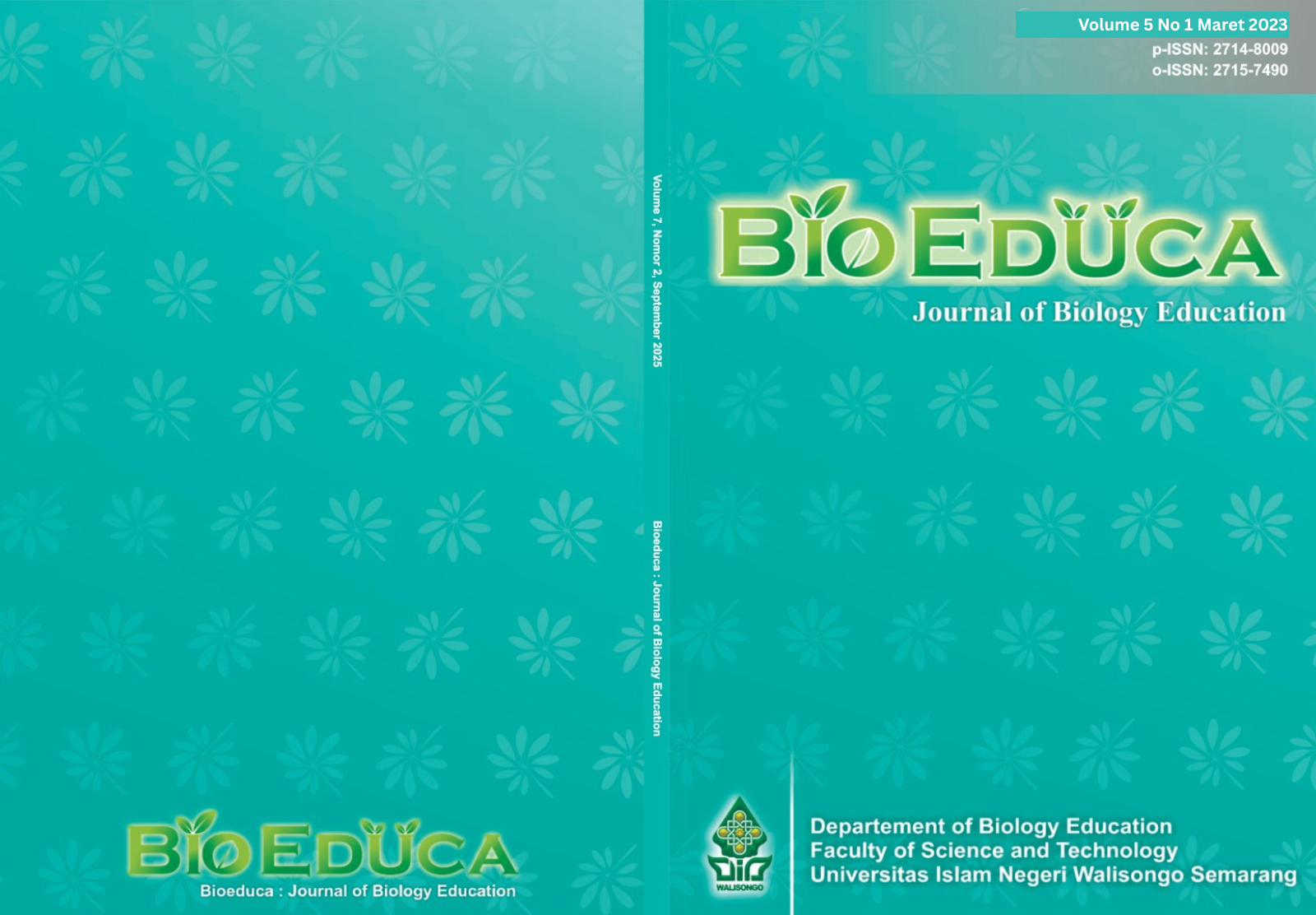Development of Science Learning E-Module Equipped with Game On Material Classification of Living Things for Grade VII Students
Main Article Content
Abstract
Downloads
Article Details
The copyright of the received article shall be assigned to the journal as the publisher of the journal. The intended copyright includes the right to publish the article in various forms (including reprints). The journal maintains the publishing rights to the published articles. Authors are allowed to use their articles for any legal purposes deemed necessary without written permission from the journal with an acknowledgment of initial publication to this journal.

This work is licensed under a Creative Commons Attribution-ShareAlike 4.0 International License.
References
Abidin, Z. (2016). Application of Selection of Learning Media. Edcomtech: Journal of Educational Technology Studies, 1 (1), 9–20.
Adrianto, H., Setyawan, Y., Banjarnahor, DP, Kusumah, IP, & Messakh, BD (2022). Provision of New Classifications of Animal Living Things to Biology Teachers. Sebatik, 26 (2), 638–643. https://doi.org/10.46984/sebatik.v26i2.2152
Annisa, AR, Putra, AP, & Dharmono. (2020). Practicality of Learning Media for Antibacterial Power of Sapodilla Fruit Extract Based on Macromedia Flash Practicality Of Learning Media for Antibacterial Power of Sapodilla Fruit Extract Based on Macromedia Flash. Science Education Innovation, 11 (1), 72-80
Anwar, M. (2017). Creating Effective Learning Through Hypnoteaching. Expose: Journal of Legal and Educational Research, 16 (2), 469–480.
Aprianty, V., Yeni, LF, & Wahyuni, ES (2016). Description of Students' Learning Difficulties in Sub-Material of Class X Invertebrates MAN 2 Pontianak. Equator Journal of Education and Learning, 5 (12), 1–13.
Arsyad, A. (2013). Learning Media. Jakarta: Rajagrafindo Persada
Asikin, N., & Daningsih, E. (2018). Development Audio-Visual Learning Media of Hydroponic System on Biotechnology Topic For Senior High Schools. Journal of Education and Humanities 174 (Ice 2017), 197–201.
Asyhar, R., Afrida., & Widiastiningsih, R. (2015). Development of E-Modules using Pageflip Professional 3D Software for Class X Chemistry Learning at Al-Falah Islamic High School, Jambi City. Journal of the Indonesian Society of Integrated Chemistry, 7 (1), 18–24.
Branch, R. M. (2009). Instructional Design : The ADDIE Approach. New York : Springer Science & Business Media
Bujuri, DA (2018). Analysis of Cognitive Development of Elementary Children and Its Implications in Teaching and Learning Activities. LITERACY (Journal of Education), 9(1).37-50
Dwi, RA, & Subagio, FM (2013). Using Image Media to Improve the Learning Process of Plants and Animals Themes in Elementary Schools. Journal of Elementary School Education, 1 (2), 1–9.
Irfan, MK, Yelianti, U., & Muhaimin. (2019). Development of 3D Pageflip-Based Biology Learning E-Module on Classification of Living Things for Class VII Students of SMP Development. Edu-Science, 8 (1), 9–16.
Kristianto, D., & Rahayu, TS (2020). Development of E-Comic Learning Media to Improve Grade IV Mathematical Problem Solving Ability. Tambusai Journal of Education, 4 (19), 939–946.
Mardliyah, AA (2018). Application of Games in Middle School Indonesian Language Teaching Materials. Journal of Education, 5 (1), 53 – 69.
Miftah, M., & Rokhman, N. (2022). Selection criteria and principles of using ICT-based learning media according to the needs of students. Educenter : Scientific Journal of Education, 1 (4), 412–420.
Mu'min, SA (2013). Jean Piaget's Theory of Cognitive Development. Al-Ta'dib Journal, 6 (1), 89-99.
Munandar, RR, Cahyani, R., & Fadilah, E. (2021). Development of Sigil Software E-Module to Improve Student Learning Outcomes During the Covid-19 Pandemic. Biodik, 7 (4), 191–202. https://doi.org/10.22437/bio.v7i4.15204
Nurkholis. (2013). Education in an Effort to Advance Technology By: Nurkholis Doctor of Education, Alumnus of Jakarta State University Extraordinary Lecturer in Tarbiyah Department, STAIN Purwokerto. Journal of Education, 1 (1), 24–44.
Nurrita, T. (2018). Development of Learning Media to Improve Student Learning Outcomes. Journal of Education, 3 (1), 171–187.
Permatasari, ANI, & Marniati. (2019). Application of the Design Making Module with the Help of Collage in the Basic Subject of Design for Class X Fashion Design at SMK Negeri 1 Buduran Sidoarjo. Journal of Education, 8 (1), 52-61
Prastowo, A. (2015). Creative Guide to Making Innovative Teaching Materials. Yogyakarta : DIVA Press
Putry, HME, Adila, VN, Sholeha, R., & Hilmi, D. (2020). Video Based Learning as a Learning Media Trend in the 4.0 Era. Tarbiyatuna: Journal of Scientific Education, 5 (1), 1–24.
Qomarul, YR, Putu, SIN, & Bagus, PMI (2018). Development of Physics Education Game Learning Media to Increase Student Motivation and Achievement in Materials of Straight Straight Motion, Regular Change, and Free Fall. Journal of Physics Learning Research, 8 (2), 21–30.
Rabayanti., Noer, AW, Afiah, N. (2021). Efforts to Improve Learning Quality Through Integrated Learning Systems. Dishum Journal, 1 (1), 22–35.
Riduwan. (2014). Research Proposal Preparation Methods & Techniques. Bandung : Alphabet
Risanto, R., Asikin, N., & Muhartati, E. (2018). Development of Macromedia Flash Learning Media on Classification of Living Beings for Class VII Students. Biology Thesis Articles 03, 2 (15), 1 – 5.
Sadiman, A., Anung, R., & Rahardjito, H. (2014). Educational Media. Jakarta: Rajawai Pers.
Sugiyono. (2019). Research and Development Methods. Yogyakarta: ALPHABETA, CV.
Sundayana, R. (2014). Education Research Statistics. Bandung: Alphabet.
Syafira, Z & Roesminingsih, MV (2020). Tutor Competency and Learning Quality at the English Is Friend Course Institute in Surabaya. Journal of Education for All. 4 (3), 82–92.
Widiana, FH, & Rosy, B. (2021). Development of Flipbook Maker-Based E-Modules in Office Technology Subjects. Educative : Journal of Education, 3 (6), 3728–3739.
Uno & Muhammad, N. (2012). Learning with the PAILKEM Approach. Jakarta: Earth Script.

